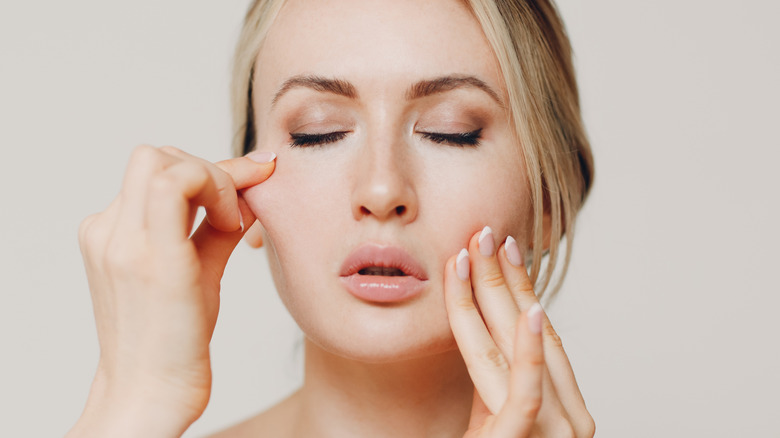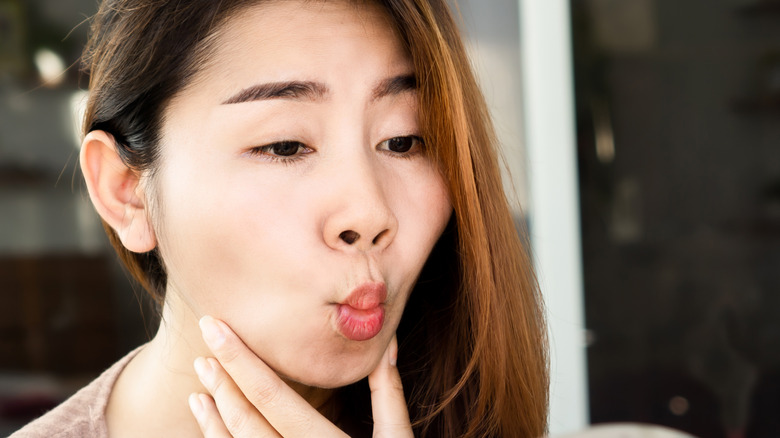Will Facial Exercises Really Give You The Anti-Aging Benefits You Want?
After joining the 30s club, you'll start seeing the natural formation of fine lines and wrinkles as your skin is less elastic. Per a study published in the journal Antioxidants, aging is characterized by progressive damage inflicted on the structures and functions of the cells and organs of an organism. The main synergizing causes of aging include oxidative stress, glycation, mutations, and protein aggregation, among others. The study claims that if we can stop or reduce the growth of one of these causes, the aging process will slow down. For instance, using products formulated with anti-glycation ingredients such as aminoguanidine, alisin, and carnosine can reduce the glycation effects and stymie the aging process, explains dermatologist Dr. Ava Shamban (via Huda Beauty).
Wholesome lifestyle habits, including facial exercises, can also contribute to tighter skin and smoother complexion, or so they say. The rationale behind this idea is that if a regular body workout can keep you in good shape, a face workout can also keep the facial muscles toned and the skin taught. That's why manual facial massages and muscle-stimulating facial devices are having a moment these days. Given that facial exercises are easy to do at your convenience, there's no harm in giving them a shot. So, can facial exercises give you any anti-aging benefits and remove the need for costly treatments? Here are some insights.
Daily facial exercises are good for your skin
As the name suggests, facial exercises involve massaging 57 muscles in your face and your neck in repetitive motions to wake up facial muscles and move lymph along. The ultimate goal of facial exercises is to reinforce your muscles and tighten your face, reducing sagging and lessening signs of aging, per Nivea. Facial exercises can also help enhance and prolong the effects of in-office anti-aging treatments. Depending on your needs, you can use exercises that target specific facial conditions in addition to working on the pressure points on your face. For instance, you can sculpt and lift your flabby cheeks by doing 10 to 15 reps of sucking your cheeks in and holding them for five seconds before releasing them. To tone a double chin, rotate your neck slowly in a repetitive motion or pucker your lips while tilting your head backward.
Recommending performance of facial exercises on a daily basis, Dermatologist Dr. Doris Day points out that most of us overuse specific facial muscles as we make expressions, which causes the opposing muscles that you use less to wear out over time (via Town & Country). For instance, when you frown frequently, you're overusing the corrugator muscles, which causes the muscles that lift and smile to weaken. Therefore, a facial workout should mirror what you do in the gym: employing various muscle groups and avoiding overloading any single particular group. Another advantage of facial exercises is that repetitive stretching can loosen up your skin and reduce the appearance of acne scars.
Their benefits are limited
Although facial exercises are loaded with benefits, they are nonetheless not without limitations and risks. According to Suzanne Olbricht, a professor of dermatology at Harvard Medical School, the benefits yielded by facial exercises are too subtle to help you accomplish what only cosmetic procedures can, such as dermal fillers. She says, "Truthfully, it's hard to say whether face exercises are useful or not." However, if you're interested in knowing how muscle manipulation techniques can impact your skin, there's no harm in incorporating them into your daily skincare routine. You can use your bare hands to press specific facial points or tools such as a sculpting bar, konjac sponge, jade roller, collagen roller, or dermal roller for a more targeted and convenient maneuver.
Meanwhile, cosmetic dermatologist Dr. Apratim Goelpoints (via DNA India) cautions that massaging your face indiscriminately and harshly might accelerate the wear and tear of the collagen fibers and worsen wrinkles. According to Dr. Goelpoints, a better approach to aging reversal is to adopt a skincare regimen of cleansing, toning, sun protection, and moisturizing as they help stimulate the fibroblast cells in the skin. When you perform facial exercises, avoid using excessive force, she says. Actually, there are many types of facial exercises that address different skin needs, from reducing acne to improving the appearance of fine lines. To optimize their efficacy, it's best to have a dermatologist or esthetician with sufficient knowledge of facial anatomy and massaging techniques perform facial exercises on you.


